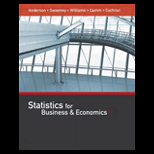
Concept explainers
To assess consumer acceptance of a new series of ads for Miller Lite Beer. Louis Harris conducted a nationwide poll of 363 adults who had seen the Miller Lite ads. The following responses are based on that survey. (Note: Because the survey sampled only a small fraction of all adults, assume (N − n)/N = 1 in any formulas involving the standard error.)
- a. Nineteen percent of all respondents indicated they liked the ads a lot. Develop a 95% confidence interval for the population proportion.
- b. Thirty-one percent of the respondents disliked the new ads. Develop a 95% confidence interval for the population proportion.
- c. Seventeen percent of the respondents felt the ads are very effective. Develop a 95% confidence interval for the proportion of adults who think the ads are very effective.
- d. Louis Harris reported that the “margin of error is five percentage points.” What does this statement mean and how do you think they arrived at this number?
- e. How might nonsampling error bias the results of such a survey?
a.
Obtain a 95% confidence interval for the population proportion.
Answer to Problem 18SE
The 95% confidence interval for the population proportion is
Explanation of Solution
Calculation:
In a nationwide poll, 19% out of 363 adults who have seen the Miller Lite ads, liked the ads a lot.
Confidence interval:
The approximate 95% confidence interval estimate of the population proportion is
Where
Substitute
Thus, the standard error of the proportion is 0.0206.
Confidence interval:
Thus, the approximate 95% confidence interval for the population proportion is
b.
Obtain a 95% confidence interval for the population proportion.
Answer to Problem 18SE
The 95% confidence interval for the population proportion is
Explanation of Solution
Calculation:
The respondents who disliked the new ads are 31%.
Substitute
Thus, the standard error of the proportion is 0.0243.
Confidence interval:
Thus, the approximate 95% confidence interval for the population proportion is
c.
Obtain approximate 95% confidence interval for the proportion of adults who think the ads are very effective.
Answer to Problem 18SE
The approximate 95% confidence interval for the proportion of adults who think the ads are very effective is,
Explanation of Solution
Calculation:
The respondents who felt the ads are very effective is 17%.
Substitute
Thus, the standard error of the proportion is 0.0197.
Confidence interval:
Thus, the approximate 95% confidence interval for the proportion of adults who think the ads are very effective is
d.
Explain the statement and find the number they got.
Explanation of Solution
Calculation:
The statement “margin of error is five percentage points” is reported by Louis Harris.
The standard error is largest when
Now,
Here by multiplying the standard error with 2 the bound is,
Hence, for the sample of 363, the bond would be 5% when
e.
Explain whether the non-sampling error biased the results of the survey or not.
Explanation of Solution
When the poll is conducted by calling people at home during day time then the sample results represents for the adults who are not working outside the home. The Louis Harris organization took precautions against this that causes bias.
Want to see more full solutions like this?
Chapter 22 Solutions
STATISTICS F/BUSINESS+ECONOMICS-TEXT
- Find the critical value for a left-tailed test using the F distribution with a 0.025, degrees of freedom in the numerator=12, and degrees of freedom in the denominator = 50. A portion of the table of critical values of the F-distribution is provided. Click the icon to view the partial table of critical values of the F-distribution. What is the critical value? (Round to two decimal places as needed.)arrow_forwardA retail store manager claims that the average daily sales of the store are $1,500. You aim to test whether the actual average daily sales differ significantly from this claimed value. You can provide your answer by inserting a text box and the answer must include: Null hypothesis, Alternative hypothesis, Show answer (output table/summary table), and Conclusion based on the P value. Showing the calculation is a must. If calculation is missing,so please provide a step by step on the answers Numerical answers in the yellow cellsarrow_forwardShow all workarrow_forward
- Show all workarrow_forwardplease find the answers for the yellows boxes using the information and the picture belowarrow_forwardA marketing agency wants to determine whether different advertising platforms generate significantly different levels of customer engagement. The agency measures the average number of daily clicks on ads for three platforms: Social Media, Search Engines, and Email Campaigns. The agency collects data on daily clicks for each platform over a 10-day period and wants to test whether there is a statistically significant difference in the mean number of daily clicks among these platforms. Conduct ANOVA test. You can provide your answer by inserting a text box and the answer must include: also please provide a step by on getting the answers in excel Null hypothesis, Alternative hypothesis, Show answer (output table/summary table), and Conclusion based on the P value.arrow_forward
 Glencoe Algebra 1, Student Edition, 9780079039897...AlgebraISBN:9780079039897Author:CarterPublisher:McGraw Hill
Glencoe Algebra 1, Student Edition, 9780079039897...AlgebraISBN:9780079039897Author:CarterPublisher:McGraw Hill Holt Mcdougal Larson Pre-algebra: Student Edition...AlgebraISBN:9780547587776Author:HOLT MCDOUGALPublisher:HOLT MCDOUGAL
Holt Mcdougal Larson Pre-algebra: Student Edition...AlgebraISBN:9780547587776Author:HOLT MCDOUGALPublisher:HOLT MCDOUGAL

